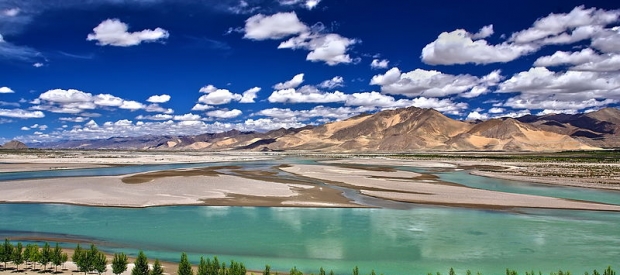Brahmaputra/Yarlung Tsangpo
The Brahmaputra River is one of the last largely free-flowing rivers emanating from the Tibetan Plateau. Originating as the Yarlung Tsangpo River, it flows across southern Tibet through the Himalayas and into India and Bangladesh before merging with the Ganges and emptying into the Bay of Bengal.
While early speculation that China planned to dam and divert the waters of the Brahmaputra to its parched north appear unfounded, China has been building the Zangmu Hydropower Station on the main stream of the middle reaches of Brahmaputra, the first of a series of five dams planned (see map). The installed capacity of the Zangmu Water Power Station will be 510 MW. The project is located in Lhokha (Shannan) Prefecture of Tibet Autonomous Region about 140 km southeast from Lhasa. On November 12, 2010, the builders of the Zangmu Hydropower Station announced the successful damming of the river. Huaneng, China's top power company, is backing the financing of the project and, Gezhouba, one of China's biggest dam construction companies, will build the project. Those living downstream, including India and Bangladesh, will likely be greatly impacted.
In January 2013, China’s State Council – the country’s ultimate decision-making body – announced its new Energy Development Plan in January, which included several controversial dams that had previously been suspended as a result of environmental concerns and public opposition. Among these were three new hydropower dams on the middle reaches of the Brahmaputra river: the 640 MW Dagu Dam (which lies 18 km upstream of Zangmu, the 320 MW Jiacha Dam (also on the middle reaches of the Brahmaputura downstream of Zangmu), and the Jiexu Dam (11 km upstream of Zangmu; the capacity of the Jiexu dam is, as yet, unconfirmed).
- Brahmaputra - The Beautiful River or The Battleground, SANDRP, 17 July 2103
- One river, two countries, too many dams, The Hindu, 2 April 2013
- China gives go-ahead for three new Brahmaputra dams, The Hindu, 30 January 2013
- A new era for Tibet's rivers, chinadialogue, 17 January 2011
- Chinese engineers propose world's biggest hydro-electric project in Tibet, The Guardian, 24 May 2010
- Gezhouba wins 1.14b yuan hydropower contract, China Daily, 4 March 2009



